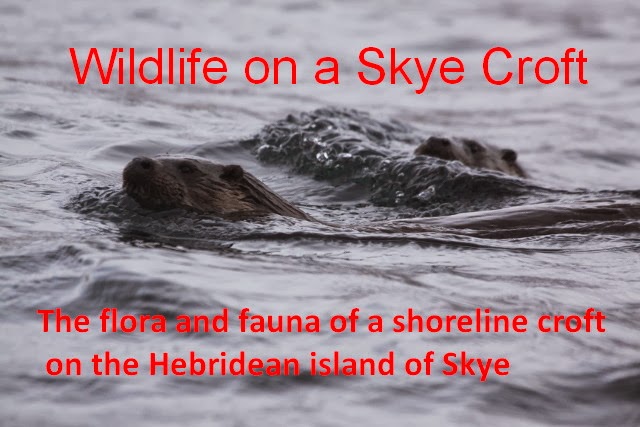Noteworthy since then I saw a pair of bullfinches in the garden on bushes near the feeders but not actually visiting the feeders - I am hoping that they are nesting nearby and there should be lots of suitable habitat.
Thursday 19 February 2015
Trail Cameras - Essential!
Earlier today I noted that we had only seen the otter family a couple of times in the last 4 weeks. Clearly we have not been concentrating enough, and putting in the amount of time needed. I have had the trail camera looking over the cliff holt for the last week, and this morning it picked up the otter family in front of the holt just after 8 am. The two clips, both short, are below. If only I had gone for my regular pre-breakfast stroll down the croft, but it just looked too uninvitingly wet underfoot, following heavy rain yesterday.
Stirring of Life
We seem to have had quite a battering this winter. January was the fourth wettest month since 2009 (308mm) , and whilst it was not one of the coldest (7 days of frost which is about normal) much of the rain fell as hail driven by strong winds which made it feel cold and miserable (statistics for Lusa from http://en.tutiempo.net/ ).
At last though there are now some stirrings of life. On the 16th there was the first clump of frogspawn in the garden pond, 8 days earlier than last year. There were three more clumps the following night. Mergansers are pairing up and several cormorants are in their courtship display. Great tits and sparrows are starting to nest and using the nest boxes in the garden as well as the house eaves (to wake us up in the morning). A few celandines are in bud.
The plant that seems to thrive despite the weather is soft rush and this week I strimmed areas of the croft where it was appearing. It is ubiquitous in damp grasslands on Skye and a persistent weed. I have a book written in 1945 by Fraser Darling,"Crofting Agriculture", which gives advice to the crofter on land use base upon his experiences on North Rona. A chapter is devoted to soft, or 'common', rush and its eradication. "A plant...can occupy a square yard of ground. The stems are packed together extremely closely and exclude most other kinds of grass. Cattle will graze the tops of young plants but sheep will not touch them, and graze carefully all round the clump, leaving the rushes in an ideal position, clear of competition". His advice is to use lime or to cut the clumps flush with the ground - which requires 'very hard work' and a grass hook. I have adopted the second alternative but fortunately I have a petrol driven strimmer to make light work of clearance! The soft rush is controlled rather than eradicated; if not it would just take over.
I managed to get the moth trap out on two nights, but it was quite cold and I caught only two moths (a dotted border and a winter moth), and only one on the second night (a micromoth, Acleris hyemana - thanks to Brian Neath and Mark Young for the identification). On the second night I also had a wood gnat in the trap.
We saw the otter family a couple of times in the last month, and there has also been a male otter around. Poor weather meant no photos.
At last though there are now some stirrings of life. On the 16th there was the first clump of frogspawn in the garden pond, 8 days earlier than last year. There were three more clumps the following night. Mergansers are pairing up and several cormorants are in their courtship display. Great tits and sparrows are starting to nest and using the nest boxes in the garden as well as the house eaves (to wake us up in the morning). A few celandines are in bud.
The plant that seems to thrive despite the weather is soft rush and this week I strimmed areas of the croft where it was appearing. It is ubiquitous in damp grasslands on Skye and a persistent weed. I have a book written in 1945 by Fraser Darling,"Crofting Agriculture", which gives advice to the crofter on land use base upon his experiences on North Rona. A chapter is devoted to soft, or 'common', rush and its eradication. "A plant...can occupy a square yard of ground. The stems are packed together extremely closely and exclude most other kinds of grass. Cattle will graze the tops of young plants but sheep will not touch them, and graze carefully all round the clump, leaving the rushes in an ideal position, clear of competition". His advice is to use lime or to cut the clumps flush with the ground - which requires 'very hard work' and a grass hook. I have adopted the second alternative but fortunately I have a petrol driven strimmer to make light work of clearance! The soft rush is controlled rather than eradicated; if not it would just take over.
 |
| Uncontrolled soft rush nearby |
 |
| Post strimming of the croft |
 |
| Micromoth (Acleris hyemana) |
.JPG) |
| Dotted Border |
We saw the otter family a couple of times in the last month, and there has also been a male otter around. Poor weather meant no photos.
Subscribe to:
Posts (Atom)

